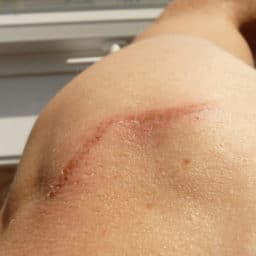Scars are made of fibrous tissue and vary in size, shape, color and texture. Scar revision surgery is a plastic surgery procedure to improve the condition or appearance of your scar.
Types of Scars
Before you undergo scar revision surgery, it is important to have an awareness of the different scar types, as this will determine which technique your surgeon will use.
- Subtle scars are marked by minor discolorations or surface irregularities, and do not cause physical discomfort. Examples include acne scars and those resulting from minor injuries or prior surgeries.
- Hypertrophic scars are comprised of thick clusters of scar tissue that develop over a wound site. They are usually raised, may cause some discomfort and are often red in appearance. They can widen over time.
- Keloids are larger and can be painful or itchy. They extend beyond the dimensions of the original wound and can appear anywhere on your body, but usually develop in areas with little underlying fat.
- Contractures occur where there is a significant amount of tissue loss, and are commonly found on burn victims. They restrict movement when skin and underlying tissue pull together during healing.
Scar Revision Options

Surface treatments are the most common type of scar revision, softening their appearance and reducing uneven pigmentation. Options include dermabrasion, laser therapy, and skin bleachers.
Raised and depressed scars can both be dramatically minimized with injections. Soft tissue fillers can lift up sunken scars, while steroids and other immune modulators placed in elevated scars can shrink them down over time.
The ultimate goal of scar revision is to make the scar blend into the surrounding skin. The healing process continues as the scars gradually fade over time. Results are long-lasting or permanent, but it may take several months to a year before they are readily apparent.
Call Barnes Facial Plastic Surgery at ENT of Athens at (706) 600-3223 for more information or to schedule an appointment.